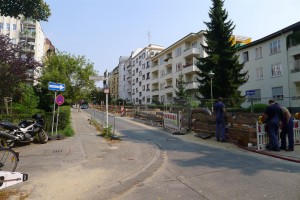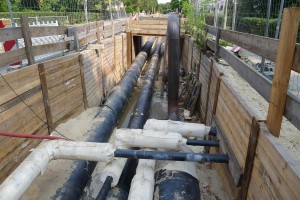District Heating in Berlin
What can I say? I’m interested in underground utilities: those hidden networks of tunnels, pipes and wires that provide so many of the services that we tend to take for granted.

This block-long excavation at the side of a residential street looked to me like it involved municipal water and Sedanstr 3 sewer pipes, but the men working on it told me that they were upgrading distribution for heat and domestic hot water. I presume that the smaller pipes with the thick white insulation are carrying heat and hot water.

Where does the hot water come from? “Ein Heitzungskessel” — a boiler.
I later learned via a quick internet search that:
Berlin ranks top among the cities in Germany with regard to its use of cogeneration systems. The city has the largest district-heating network in Western Europe. A 1,600-kilometer network of pipes delivers heat to consumers using resource-conserving technologies. Over 280 cogeneration plants across the city provide reliable and environmentally friendly heat and electricity. Nearly 30 percent of the district-heating market in Berlin is supplied by cogeneration plants, and the city has long-term plans to boost this percentage further.
So a distributed network of cogeneration plants, fired primarily by natural gas and coal, creates electricity and heat for a significant portion of the city.
Before we arrived in Germany, I had been planning to look into the biomass-fired (wood chips and pellets) district heating systems that have been developed in Northern Austria. I was not expecting to find examples of district heating systems under my feet in Berlin.
